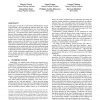Free Online Productivity Tools
i2Speak
i2Symbol
i2OCR
iTex2Img
iWeb2Print
iWeb2Shot
i2Type
iPdf2Split
iPdf2Merge
i2Bopomofo
i2Arabic
i2Style
i2Image
i2PDF
iLatex2Rtf
Sci2ools
PVLDB
2010
2010
HYRISE - A Main Memory Hybrid Storage Engine
In this paper, we describe a main memory hybrid database system called HYRISE, which automatically partitions tables into vertical partitions of varying widths depending on how the columns of the table are accessed. For columns accessed as a part of analytical queries (e.g., via sequential scans), narrow partitions perform better, because, when scanning a single column, cache locality is improved if the values of that column are stored contiguously. In contrast, for columns accessed as a part of OLTP-style queries, wider partitions perform better, because such transactions frequently insert, delete, update, or access many of the fields of a row, and co-locating those fields leads to better cache locality. Using a highly accurate model of cache misses, HYRISE is able to predict the performance of different partitionings, and to automatically select the best partitioning using an automated database design algorithm. We show that, on a realistic workload derived from customer applicati...
Cache | Columns | Main Memory | PVLDB 2010 |
| Added | 30 Jan 2011 |
| Updated | 30 Jan 2011 |
| Type | Journal |
| Year | 2010 |
| Where | PVLDB |
| Authors | Martin Grund, Jens Krüger, Hasso Plattner, Alexander Zeier, Philippe Cudré-Mauroux, Samuel Madden |
Comments (0)

